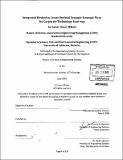Integrated method to create optimal dynamic strategic plans for corporate technology start-ups
Author(s)
Mikati, Samir Omar
DownloadFull printable version (22.98Mb)
Other Contributors
Massachusetts Institute of Technology. Engineering Systems Division.
Advisor
Richard de Neufville.
Terms of use
Metadata
Show full item recordAbstract
This thesis presents an innovative method for evaluating and dynamically planning the development of uncertain technology investments. Its crux centers on a paradigm shift in the way managers assess investments, toward an approach that incorporates uncertainty in the beginning phases of planning instead of first choosing a plan and then considering the effect of risk. By proactively identifying critical uncertainties and "purchasing" flexibility to handle them, management can increase the value of the start-up technology. The method builds on extensive literature in corporate venture capital (CVC), opportunity identification, and opportunity development, to present a new integrated approach that: 1. Explicitly identifies the synergies between an investing company and an opportunity, and articulates the new value network created through a Technology-Implement-Commercialization (TIC) linkage framework. 2. Develops the opportunities articulated in the TIC networks using a tool that identifies current and goal positions for a set of critical issues, and states the critical uncertainties. 3. Combines the outcomes of the TIC and opportunity development steps in a decision analysis of the possible development paths. The result is a recommended dynamic strategy that invests initially in some form of flexibility to enable program directors to avoid paths that eventually appear unproductive, while seizing opportunities that develop along the course of the project. The thesis demonstrates the approach by applying it to a start-up project in solar concentrators, done from the perspective of a corporate sponsor. (cont.) The purpose of this case study is to provide a comprehensive guide to the process used in the new method. While extensive effort was dedicated to creating a representative and reasonably accurate assessment, the analysis and numbers are neither authoritative nor exhaustive. The goal, indeed a major contribution of the thesis, is to provide a teaching tool to aid future use of the innovative planning and valuation method.
Description
Thesis (S.M.)--Massachusetts Institute of Technology, Engineering Systems Division, 2009. "June 2009." Cataloged from PDF version of thesis. Includes bibliographical references (p. 133-139).
Date issued
2009Department
Massachusetts Institute of Technology. Engineering Systems DivisionPublisher
Massachusetts Institute of Technology
Keywords
Engineering Systems Division.